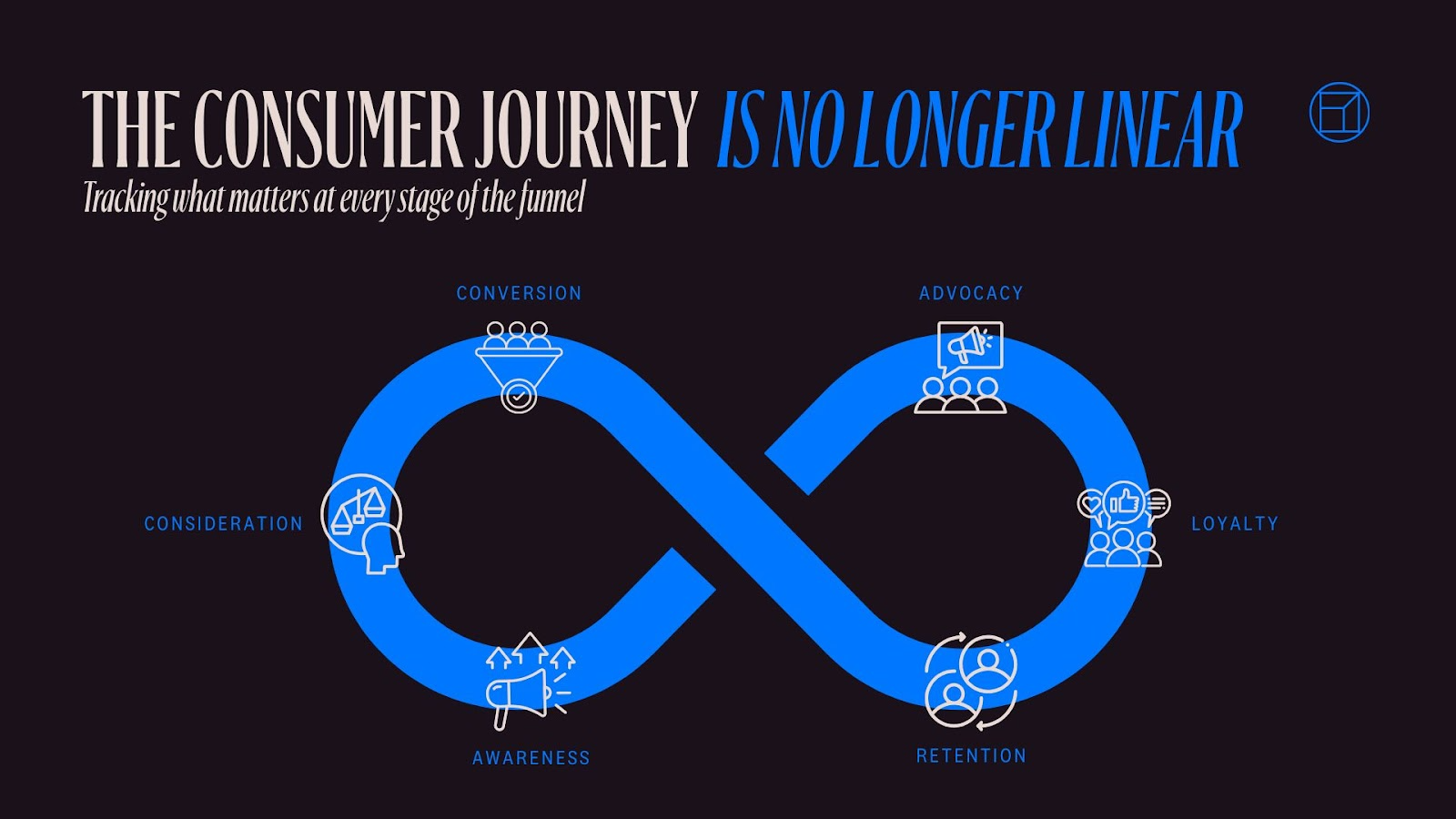In today’s digital world, we all receive marketing messages from multiple channels, with the average U.S. consumer spending 6 hours and 38 minutes a day across various screens. For example, they might scroll the news on their phone for breakfast, use a laptop during the workday, stream TV at night, and relax in bed with a tablet before falling asleep. The customer journey is no longer linear, and with so many touchpoints in play, it can be challenging for marketers to track which touchpoints are actually driving conversions.
Enter: multi-touch attribution.
With multi-touch attribution models, marketers can see the full customer journey, from the first point of contact to the final point of purchase. Whether it’s seeing an ad on social media, streaming TV, getting an email, or more, multi-touch breaks down every touchpoint between your brand and the customer, giving you the ability to focus on the tactics that work and refocus the ones that don’t. Think of it as attribution for the information age.

Why Multi-Touch Is Different
While first- and last-touch attribution models have been important for marketers, they no longer encapsulate the complex customer journeys of today’s buyers. For a multi-touch attribution example, let’s say that a customer saw a social post for a DTC product, read customer reviews, visited the website to learn more, and then converted.
First-touch attribution would say that the social media post is responsible for the conversion, while last-touch attribution would argue that a customer just came to the website to buy. Both miss the bigger picture: that each touchpoint is a puzzle piece in a larger puzzle, slowly filling in the value proposition that made the customer buy.
In contrast, multi-touch attribution would consider every touchpoint in the above and assign credit to each based on the amount of influence it had on the customer’s conversion. As a result, single-touch attribution models like first- and last-touch are less helpful, whereas multi-touch gives you a clearer picture of how influential your channels and touchpoints are. This can be incredibly beneficial for marketers, helping them enhance these touchpoints to optimize future customer journeys and minimize the time between introduction and conversion.
Multi-touch attribution also differs from multi-channel, another competing attribution model, in key ways. Multi-channel attribution only assigns credit to channels that a customer interacts with on their customer journey. In this model, a higher-level focus is made on conversions from channels and the marketing used.
In contrast, multi-touch attribution models give details on the specific platforms the ad appeared on. So, while multi-channel would tell you how many conversions came from the social media channel, multi-touch digs deeper and tells you exactly which channels are converting. This helps you focus your ad budget on high-performance channels and not increase spend on the ones that aren’t.

Types of Multi-Touch Models
There are multiple types of multi-touch attribution models available, each weighing multiple touchpoints differently. Some of the more popular variations include:
Linear Attribution: Also known as an even-weighting attribution model, linear gives equal conversion credit to every touchpoint in the buyer’s journey. Linear attribution is sometimes considered the “standard” model in multi-touch attribution.
Time Decay Attribution: This model gives more weight to the touchpoints that are closer to the moment of conversion. It assumes that the closer a touchpoint is to the point of purchase, the more influence it has.
U-Shaped Attribution: Also known as the bathtub model, the U-shaped attribution model assigns more importance to the first and last touchpoints in the buyer’s journey, giving them higher credit than the touchpoints in the middle.
W-Shaped Attribution: Similar to the U-shaped model, the W-shaped attribution model gives credit to the first, last, and middle touchpoints that occur in the buyer’s journey. All remaining touchpoints are then given equal credit.
Full-Path Attribution: The most complex multi-touch model available, full-path tracks every marketing interaction from a customer, including the final touchpoint. Marketers then distribute weight by prioritizing key touchpoints, equally weighing all remaining touchpoints.
SEO and AI’s Impact on Multi-Touch Attribution
SEO often plays an underrated but essential role in multi-touch attribution. Unlike paid media, which tends to dominate last-click conversions, SEO is a powerful driver at the top and middle of the funnel. Many buyers first discover a brand through organic search long before they’re ready to convert, first reading blog posts, guides, and product pages.
In a multi-touch attribution model, these early interactions appear as “assist” touches that shape awareness and build trust. While they develop the familiarity that makes later paid ad clicks and email campaigns more effective, without attribution modeling, their influence goes unrecognized.
The challenge with SEO is that its impact isn’t always linear or easy to measure. Organic traffic can come from branded and non-branded searches, keywords are often hidden in analytics, and users may engage with multiple organic pages across their journey. Still, when analyzed in a multi-touch framework, SEO typically earns more credit than in traditional last-touch models, since it drives both discovery and consideration.
By separating branded from non-branded traffic, tracking assisted conversions, and connecting SEO metrics to downstream revenue, marketers can see how organic search doesn’t just “bring free clicks;” it actively powers the customer journey alongside paid and owned channels.
Similarly, artificial intelligence is also changing multi-touch attribution, making it easier for marketers to better understand their touchpoints’ value. With AI, marketers can get faster insights, test and learn, and use that data to optimize their touchpoints instantly.
By streamlining the entire multi-touch process and efficiently applying budgets to high-performing channels, marketing teams can save precious time and energy. AI also powers unique multi-touch attribution models, including:
Fractional Attribution: This model uses machine learning to calculate and assign fractional credit to success metrics for influential touchpoints. Models are rebuilt often, sometimes daily, giving marketers the ability to optimize decisions on the fly for in-progress campaigns.
Incremental Attribution: Incrementality tracks the measure of your ad spend’s impact on conversion rates. It helps determine where to spend a budget and how much should be spent.

Conclusion
Today, it’s more crucial than ever to understand the true impact of your advertising, especially when it comes to the unique conversions and revenue you’re driving. As consumer behavior shifts to an omni-channel buying experience, advertisers need to keep up by deploying smarter methods of following a more complex buyer’s journey.
Multi-touch attribution makes it easier than ever to define your marketing team’s successes, protect budgets and teams, create effective marketing strategies, and advertise smarter.
Take the guesswork out of your advertising. Connect with Blue Wheel and start optimizing with multi-touch attribution.







.png)
.png)
